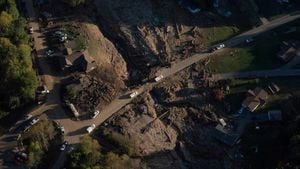Northern California is set for a rare celestial spectacle this weekend, as the region could witness the stunning northern lights, also known as aurora borealis, thanks to a potent solar storm. According to the National Oceanic and Atmospheric Administration (NOAA), these dazzling lights might illuminate the night sky from Friday through Sunday, reaching as far south as Alabama and possibly Northern California.
On Thursday, NOAA's Space Weather Prediction Center issued an alert about the geomagnetic storm, classified as G4 on the geomagnetic storm scale. This level of disturbance is particularly noteworthy; it’s been nearly two decades since NOAA last issued such a watch. "Watches at this level are very rare," remarked NOAA, emphasizing the strength of the imminent storm.
The forecast is exciting for enthusiasts and casual observers alike. The auroras are typically associated with solar activity, characterized by bursts of energy from the sun. Professor Kyle Watters from Sacramento State explained how the sun's high-energy particles interact with Earth's atmosphere, creating vibrant light displays visible near the poles. During this upcoming event, the energies emitted by the sun could make it possible for individuals across the northern half of the United States—and potentially beyond—to catch sight of these ethereal lights.
But what causes the northern lights? The phenomenon occurs when charged particles from the sun collide with oxygen and nitrogen atoms present high above Earth. Watters elaborated, saying, "What ends up happening is those trapped charged particles put on a really pretty light show." Typically, these displays happen at heights of 80 to 500 kilometers above the earth's surface. The recent storm's intensity could push the southern boundary of the auroras much closer to California, tantalizing sky watchers.
Recent history puts momentum on the side of aurora enthusiasts; sightings were reported as far south as Central California during similar solar events this year. March 2023 witnessed northern lights gracing the California sky, and the trend continued with more reported sightings later last year. With the solar activity approaching its peak phase, something stunning may happen soon.
This surge of solar activity is part of the natural solar cycles experienced by the sun, which have periods of quiet and activity approximately every 11 years. Currently, we are nearing the maximum phase of solar Cycle 25, lasting longer than expected and prompting anticipation for additional solar events and, hence, potential more frequent aurora sightings.
Astrophysicist Sushant Mahajan noted, "There is significant potential to see more space weather events," giving hope to those eager to catch another glimpse of these beautiful phenomena. The sun, during its active phases, tends to increase the number of sunspots, regions on its surface with high magnetic activity, which is directly tied to solar eruptions and solar flares. The more sunspots, the higher the likelihood of coronal mass ejections (CMEs) impacting Earth.
Although the imminent storm is primarily focused on visual appeals, it serves to highlight potential technological impacts as well. NOAA cautioned readers about possible disruptions to satellite operations, increased issues with GPS systems, and heightened electrical systems' strain due to voltage control problems. This storm's magnetic disturbance is strong enough to affect radio communications, particularly at higher latitudes.
For Northern Californians eager to witness the colorful cosmic dance, conditions should be optimal depending on cloud coverage. The best viewing sites are those far from urban light pollution, with open fields or elevated areas being ideal. NOAA has recommended specific regions known for their darker skies, unimpeded views of the northern horizon, and minimal atmospheric interference.
Interestingly, the solar storm of May brought about displays much lower than typical regions where the auroras are seen, fueled by one of the most significant solar outbursts since 2003. Reports of vibrant auroras came pouring from states like Montana and North Dakota, with residents sharing pictures and experiences online.
Yet, as fans of the northern lights prepare to chase this year's displays, they cannot ignore the potential dangers associated with solar storms. Historical records highlight massive solar storms affecting global communication systems hundreds of years ago. The infamous Carrington Event of 1859 is often cited, as it knocked out telegraph services and caused telegraph stations to emit sparks, even triggering fires.
The interplay between stunning displays and potential technological disruptions poses interesting questions. A storm large enough to create vibrant auroras at lower latitudes could also cause chaos for satellites, power grids, and GPS infrastructure across the US. Bill Murtagh, from the NOAA Space Weather Prediction Center, highlighted the contradiction: "Everyone across the nation loves the aurora borealis ... The bigger the storm, the more visible the aurora, the farther south it’s visible. But at the same time, we can’t be hoping for these big displays, because with them come the threat to our infrastructure."
California should prepare for yet another opportunity to marvel at this awe-inspiring natural phenomenon. NASA and NOAA are closely monitoring solar activities, providing updates on any forthcoming events, and building excitement about the uniqueness of these potential aurora sightings.
So for those with the right conditions, some spare time, and perhaps the right company, it may well be the weekend to keep eyes to the sky and dream of dancing lights across the California horizon post-midnight. What might illuminate the night could be more than just city lights and stars; it could well be nature putting on its most enchanting display yet.



